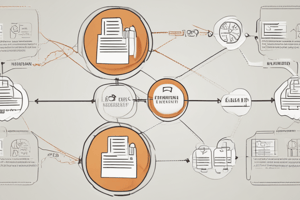Podcast
Questions and Answers
What is the primary purpose of delegation in management?
What is the primary purpose of delegation in management?
- To increase the manager's workload and responsibilities.
- To empower employees by granting them decision-making authority. (correct)
- To decrease cooperation among team members.
- To centralize control within the organization.
What is meant by decentralization in the context of organizational management?
What is meant by decentralization in the context of organizational management?
- Concentration of authority at top management levels.
- Reduction of employee involvement in decision-making.
- Dispersion of authority to various levels within the organization. (correct)
- Standardization of procedures across all levels.
Which of the following describes job simplification?
Which of the following describes job simplification?
- Creating broad job roles with minimal structure.
- Assigning a wide variety of tasks to employees.
- Encouraging collaboration among team members.
- Standardizing work procedures with high task specialization. (correct)
How does high task specialization typically affect job scope?
How does high task specialization typically affect job scope?
What management trend is associated with greater employee empowerment?
What management trend is associated with greater employee empowerment?
What organizational trend involves cutting unnecessary levels of management to create flatter structures?
What organizational trend involves cutting unnecessary levels of management to create flatter structures?
What does a wider span of control in an organization imply?
What does a wider span of control in an organization imply?
Which of the following best describes less unity of command in modern organizations?
Which of the following best describes less unity of command in modern organizations?
Which organizational structure is characterized by an emphasis on flat management with fewer levels?
Which organizational structure is characterized by an emphasis on flat management with fewer levels?
What is a key feature of decentralization in organizational trends?
What is a key feature of decentralization in organizational trends?
Which type of teams are formed across job functions to address specific goals?
Which type of teams are formed across job functions to address specific goals?
What trend reflects a move away from traditional models where one person reports to one boss?
What trend reflects a move away from traditional models where one person reports to one boss?
Which of the following is NOT a characteristic of shorter chains of command?
Which of the following is NOT a characteristic of shorter chains of command?
Which core job characteristic refers to the variety of skills needed to perform a job?
Which core job characteristic refers to the variety of skills needed to perform a job?
What is one method to enrich jobs by improving core job characteristics?
What is one method to enrich jobs by improving core job characteristics?
Which alternative work arrangement allows employees to complete a full-time job in less than five days?
Which alternative work arrangement allows employees to complete a full-time job in less than five days?
What are the perceived benefits of a compressed workweek?
What are the perceived benefits of a compressed workweek?
What is a key feature of flexible hours in a workplace?
What is a key feature of flexible hours in a workplace?
Which alternative arrangement allows employees to work from home?
Which alternative arrangement allows employees to work from home?
What does 'vertical loading' in job enrichment involve?
What does 'vertical loading' in job enrichment involve?
What is a disadvantage associated with a compressed workweek?
What is a disadvantage associated with a compressed workweek?
What is a potential disadvantage of job simplification?
What is a potential disadvantage of job simplification?
What does job rotation primarily aim to increase?
What does job rotation primarily aim to increase?
How does job enlargement differ from job enrichment?
How does job enlargement differ from job enrichment?
What does horizontal loading refer to?
What does horizontal loading refer to?
Which of the following is NOT a potential advantage of job simplification?
Which of the following is NOT a potential advantage of job simplification?
What is one major aim of job enrichment?
What is one major aim of job enrichment?
Which aspect does job enrichment focus on compared to job enlargement?
Which aspect does job enrichment focus on compared to job enlargement?
Which phrase best describes job enlargement?
Which phrase best describes job enlargement?
What is one potential benefit of flexible working hours?
What is one potential benefit of flexible working hours?
What is job sharing?
What is job sharing?
What characterizes telecommuting?
What characterizes telecommuting?
Which of the following is a potential disadvantage of telecommuting?
Which of the following is a potential disadvantage of telecommuting?
What is the primary distinction of part-time work?
What is the primary distinction of part-time work?
Which scenario best illustrates work sharing?
Which scenario best illustrates work sharing?
Which of these is NOT an advantage of telecommuting?
Which of these is NOT an advantage of telecommuting?
What percentage of the American workforce do contingency workers currently make up?
What percentage of the American workforce do contingency workers currently make up?
Flashcards
Delegation
Delegation
The process of entrusting work to others by giving them the right to make decisions and take action.
Accountability in Delegation
Accountability in Delegation
When a manager grants authority to an employee, they are also making the employee accountable for the results of their actions.
Decentralization
Decentralization
The distribution of decision-making authority to various levels of the organization, not just the top.
Task Specialization
Task Specialization
Signup and view all the flashcards
Job Simplification
Job Simplification
Signup and view all the flashcards
Flatter Structures
Flatter Structures
Signup and view all the flashcards
Shorter Chains of Command
Shorter Chains of Command
Signup and view all the flashcards
Wider Spans of Control
Wider Spans of Control
Signup and view all the flashcards
Less Unity of Command
Less Unity of Command
Signup and view all the flashcards
Cross-Functional Teams
Cross-Functional Teams
Signup and view all the flashcards
Delegation & Empowerment
Delegation & Empowerment
Signup and view all the flashcards
Alternative Job Arrangements
Alternative Job Arrangements
Signup and view all the flashcards
Skill Variety
Skill Variety
Signup and view all the flashcards
Task Significance
Task Significance
Signup and view all the flashcards
Autonomy
Autonomy
Signup and view all the flashcards
Feedback
Feedback
Signup and view all the flashcards
Compressed Workweek
Compressed Workweek
Signup and view all the flashcards
Flexible Hours
Flexible Hours
Signup and view all the flashcards
Job Sharing
Job Sharing
Signup and view all the flashcards
Telecommuting
Telecommuting
Signup and view all the flashcards
Potential Advantages of Job Simplification
Potential Advantages of Job Simplification
Signup and view all the flashcards
Potential Disadvantages of Job Simplification
Potential Disadvantages of Job Simplification
Signup and view all the flashcards
Job Rotation
Job Rotation
Signup and view all the flashcards
Job Enlargement
Job Enlargement
Signup and view all the flashcards
Job Enrichment
Job Enrichment
Signup and view all the flashcards
Horizontal Loading
Horizontal Loading
Signup and view all the flashcards
Vertical Loading
Vertical Loading
Signup and view all the flashcards
Flexible Working Hours
Flexible Working Hours
Signup and view all the flashcards
Work-at-Home
Work-at-Home
Signup and view all the flashcards
Advantages of Telecommuting
Advantages of Telecommuting
Signup and view all the flashcards
Disadvantages of Telecommuting
Disadvantages of Telecommuting
Signup and view all the flashcards
Part-Time Work
Part-Time Work
Signup and view all the flashcards
Study Notes
Organizational Trends in the Modern Marketplace
- Current trends in organizational structures are analyzed.
- Various alternative job arrangements are explained.
- A review of six organizational structures is requested. These include functional, divisional, matrix, team, network, and boundaryless structures.
Success Criteria
- The ability to analyze current organizational structure trends is a key criterion.
- Understanding and explaining alternative job arrangements is also important.
Review of Organizational Structures
- The notes request that the reader draw 6 different organizational structures (functional, divisional, matrix, team, network, boundaryless).
Organizing Trends Changing the Workplace
- Shorter chains of command: The line of authority is being streamlined by reducing unnecessary managerial levels. Flatter structures are seen as a competitive advantage.
- Less unity of command: Employees may report to multiple supervisors, especially in cross-functional teams or horizontal organizations.
- Wider spans of control: Fewer management levels mean managers oversee more subordinates with less direct supervision.
- More delegation and empowerment: Managers entrust more decision-making power to employees.
- Decentralization: Authority is dispersed to various levels of the organization. Delegation/empowerment and horizontal structures contribute to decentralization.
- Alternative work arrangements such as flexible hours, compressed workweeks, telecommuting, job sharing, and part-time work.
Specialization
- Task specialization: The degree to which workers concentrate on specific tasks. More specialization means less variety in tasks.
- Job specialization (high): Standardizes work procedures and concentrates employees on specific tasks. This often leads to simplified jobs and narrow job scopes.
- Potential advantages of job simplification: Easier and quicker training, easier supervision, easy worker replacement, development of expertise in repetitive tasks.
- Potential disadvantages of job simplification: Reduced job satisfaction, increased tardiness/absenteeism, worker boredom.
- Moderate Specialization: Job rotation and job enlargement aim to increase task variety.
- Job rotation involves shifting workers to different jobs with varying tasks.
- Job enlargement combines several tasks previously performed by different workers into a single role. This increases the range of duties for an employee.
- Job enrichment (low specialization): Builds in opportunities for greater satisfaction by expanding both job scope and depth (through vertical loading). Job enrichment differs from job enlargement by adding higher-level tasks.
Alternative Job Arrangements
- Compressed workweek: A full-time job completed in fewer than 5 days. This can increase leisure time and reduce commuting costs.
- Flexible hours: Allows employees more choice in scheduling work hours but requires a core time when all employees must be present.
- Job sharing or Work sharing: One full-time job is split between two or more people. This is another arrangement employees can use for avoiding layoffs and/or keeping their work hours.
- Telecommuting or Work-at-home: A portion of scheduled work is completed outside the office using technology to link with clients or customers.
- Part-time work: Work on a schedule of fewer hours than a full-time workweek. The work is still considered part of the full work plan (schedule). This type of work is done to supplement the workforce, also known as contingency workers. Contingency workers now constitute 30 percent of the American workforce.
How to Enrich Jobs
- Core job characteristics contribute to job enrichment, such as:
- Skill variety: The different skills required for the job.
- Task significance: The importance of the job.
- Autonomy: The amount of control employees have over their work.
- Feedback: How much information employees receive about their performance.
- Improving core job characteristics:
- Combining tasks, opening feedback channels, using vertical loading.
Studying That Suits You
Use AI to generate personalized quizzes and flashcards to suit your learning preferences.
Related Documents
Description
Explore the latest trends in organizational structures that are shaping the modern marketplace. This quiz covers various job arrangements and provides a detailed review of six primary organizational structures, including functional and matrix. Understand how these trends are influencing workplace dynamics and management strategies.




